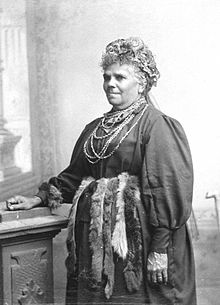Fanny Cochrane Smith
Fanny Cochrane Smith (* December 1834 in Wybalenna on Flinders Island , † February 24, 1905 in Cygnet in Tasmania ) was the last of the "purebred" Tasmanians , an Aborigine . Since two songs were engraved by her on wax cylinders , she has left the only surviving reproduction of an indigenous Tasmanian language for posterity .
Early years in Wybalenna
Her parents were among the last 220 surviving Aborigines who were deported to Wybalenna on Flinders Island by the British colonizers until April 1834 after the Black War and the so-called Black Line in Tasmania . Her mother's name was Tanganutura and her father was Nicermenic . They were deported to Flinders Island by George Augustus Robinson . In 1842 she started school at the Queen Orphan School in Hobart. She lived in Hobart with the catechist Robert Clark, who kept her in appalling misery, neglect and brutality. When she worked at Clark when she was twelve, she was paid £ 2 and 10 shillings a year.
Life at Oyster Cove
When Wybalenna was closed in 1847, Fanny Cochrane and her family came with a group of 47 surviving Aborigines from Wybalenna to Oyster Cove, south Hobart , where her father died in 1849. There she lived with her children in a simple wooden house. They grew their own groceries and had an income from selling wood that they felled and brought to Hobart, 50 kilometers away. She later lived in an area of 121 hectares awarded by the Tasmanian Parliament, hunting, collecting bush food and medicinal herbs, woving containers, diving for mussels, and cultivating Tasmanian traditions.
She married the Englishman William Smith in 1854.
She entered the Methodist Church and was very respected by the white congregation. She died of pneumonia, and after her death there was a discussion about whether she or Truganini was the last purebred Tasmanian Aboriginal. When Truganini died in 1876, Cochrane Smith was known as last Tasmania (last Tasmanian woman).
Descendants as Tasmanians
Much of today's Tasmanian Aboriginal people are descendants of Fanny Cochrane Smith, who had 11 children with her husband. She and Dolly Dalrymple , who gave birth to 13 children, are considered by the Tasmanian Aboriginal Center to be the crucial lineage of the Tasmanians living today .
Tasmanian songs and language
Cochrane Smith is best known for singing Tasmanian songs in 1899 and 1903, which were engraved on wax cylinders. It is the only surviving rendition of an indigenous Tasmanian language. The images are now in the Tasmanian Museum and Art Gallery (TMAG) in Hobart, Tasmania.
Fanny Cochrane Smith's songs were reproduced by Australian folk singer Bruce Watson in the 1988 song The Man and the Woman and the Edison Phonograph ( The Man and the Woman and the Edison Phonograph ). Watson's grandfather Horace initiated the playback of their songs, and there is a photograph of Fanny Cochrane Smith and Horace Watson in a collection at the National Museum of Australia .
Web links
- State Library of Tasmania Images (Photos by Fanny Cochrane Smith)
- Australian Dictionary of Biography Online Edition
Individual evidence
- ↑ Information about Wybalenna at www.utas.edu.au
- ^ A b c d e J. Clark: Smith, Fanny Cochrane (1834–1905) , p. 642, Australian Dictionary of Biography, Volume 11, Melbourne University Press, 1988 . Retrieved July 15, 2009
- ↑ Other sources assume 150 and 300 respectively
- ↑ Fanny Cochrane Smith (1834–1905) Tasmanian Aboriginal Significant Tasmanian Women Project - Tasmania ( Memento of the original from February 25, 2008 in the Internet Archive ) Info: The archive link was inserted automatically and has not yet been checked. Please check the original and archive link according to the instructions and then remove this notice. . Retrieved July 15, 2009
- ^ Department of Premier and Cabinet . Retrieved December 19, 2015
- ^ Edison Phonograph Song (5:55) by Bruce Watson with Ronnie Summers. Fanny Cochrane Smith's voice recordings can be found at the beginning and end of the song.
- ↑ Musicological Society of Australia ( Memento of the original from July 19, 2008 in the Internet Archive ) Info: The archive link was automatically inserted and not yet checked. Please check the original and archive link according to the instructions and then remove this notice. . Retrieved July 15, 2009
| personal data | |
|---|---|
| SURNAME | Cochrane Smith, Fanny |
| ALTERNATIVE NAMES | Smith, Fanny |
| BRIEF DESCRIPTION | Aboriginal writer, political activist |
| DATE OF BIRTH | December 1834 |
| PLACE OF BIRTH | Tasmania |
| DATE OF DEATH | February 24, 1905 |
| Place of death | Port Cygnet , Tasmania |
